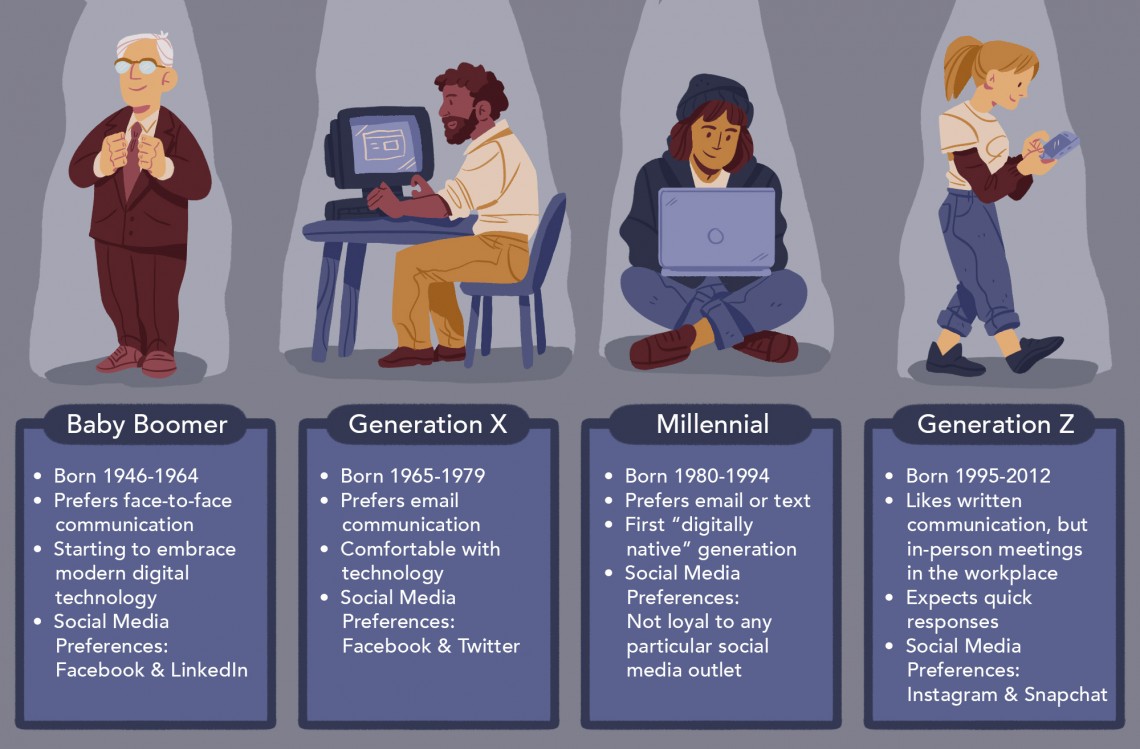Cross Generational Communication - Who are you tawkin to… me?
Posted on January 07, 2021
By Theresa Chiechi, Designer, Illustrator, Writer

Not everyone communicates in the same way. Depending on a person’s age, the way they were raised, where they live, each person has their own perspective and will therefore respond to and interpret communication differently. It is in the best interest of companies to be aware of the way different demographics communicate and one factor to hone in on could be age. Focusing on the difference between age groups can help you to implement better communication tactics in the work environment and in marketing strategies.
Let’s talk generations
You’ve likely heard of terms like “baby boomers” and “millennial” and are aware of the conversation around distinguishing the characteristics of the different generations.
What’s missing from this conversation is the acknowledgment that these labels are arbitrary, merely acting as convenient shorthand. While there are some patterns to be recognized between the generations, they are by no means a steadfast truth. It often ignores other factors such as where they live, race, economic class, and many other influences that will shape they way a person behaves and thinks. The habits of people within a generation will even change as they age. Though technology has grown exponentially within the past few decades, people have not changed all that much throughout history. Youths will act similarly whether it is present or was fifty years ago. A person in their fifties today, might share similar thinking patterns as someone from Ancient Greece.
In 370 BC, Plato gawked at the invention of writing saying, “Writing is a step backward for truth.” With the invention of the printing press in 1458, a prominent monk decried, “printed books will never be the equivalent of handwritten codices.” In 1877, The New York Times attack Alexander Graham Bell’s newly developed telephone, writing, “We will soon be nothing but transparent heaps of jelly to each other.”
Now, old folks, raise your hand if you’ve ever scoffed at the use of social media and people’s dependency on the Internet?
Generalizing thousands of people can run you into some trouble. People are individuals. Generations are not a hive mind. Just because someone is the same age as another, does not mean they will behave the same way.
As long as you keep that reality in mind, learning about some generational similarities could be a good stepping-stone to help you communicate better.
The Big Five
We are living during a unique time where there are five different generations in the workplace. The birth years for each generation will be different depending on your source, but generally the generations are defined as the following:
Silent Generation: 1925-1945
Baby Boomers: 1946 - 1964
Generation X: 1965-1979
Millennials: 1980 - 1994
Generation Z: 1995 – 2012
According to the Pew Research Center, as of 2017, people aged 21-36 made up 35 % percent of the workforce. Workers aged 37 – 52, followed them at 33 %. The next largest age bracket, 53 to 71, made up 25% of the labor force. At 5% were people 16-20. And in last place, came people over the age of 71 who made up 2%.
Workplace communication by generation
A successful business starts from within. You may look at your employees and find that they span a wide array of ages. You have to make sure you’re communicating in a way that works for everyone. This applies to face-to-face and online interactions.
We live in a digital era. Nowadays, especially with COVID-19 limiting our in-person interactions, most business communicate with their employees and to their costumers online. But different generations may interpret written communication differently.
One comical example is with the use of ellipsis. Older generations may see the “…” at the end of a sentence as a way to create mystery or even just another way to punctuate one’s thought. But if you were to ask a younger person to interpret the usage, they will often view it with a negative connotation. The ellipses, to them, could be seen as passive-aggressive or ominous.
Baby Boomers
People ranging from age 53 to 71 are used to face-to-face communication as their preferred form of communication. There’s nothing better to solidify a connection then to see someone, literally, eye to eye in person. If not face-to-face, the telephone is a worthy substitute. But as far as technology after that, things start to get shaky. Baby Boomers can range from just now embracing technology to still calling up their grandchildren to explain to them what an “email” is. In summation: face-to-face is best, telephone will do, you might be able tor reach them via email, and good luck with social media.
Generation X
These folks lived a good chunk of their lives before the digital age, but were also introduced to it at an early enough age to enable them to become tech savvy. This generation was the earliest adopters of the email and it is now their primary method of communication. While they are familiar enough with Internet as it stands today, you still might seen them missing from many popular social media platforms.
Millennials
This generation is considered the first “digitally native” generation, meaning that they grew up with the Internet and cellphones, already primed for the dawn and development of social media.
Millennials grew up with texting as their preferred way to communicate. As a result, today you’ll find many a millennial preferring written communication over in-person or over the phone. You’ll find most of them leaving meetings, firmly believing that it could’ve been an email.
Generation Z
Generation Z is often left out of this conversation since they are just now old enough to enter the workforce. Much is yet to be seen about how they communicate in this environment. Like Millennials, they grew up with heavy usage of the Internet and cellphones. However, while Millennials grew up with a developing Internet, Gen Z had advantage of a much more advanced form of technology. They are used to light-fast Internet connections and smart phones and therefore expect a fast response to their messages. But even so, when it comes to workplace interactions, they actually prefer in-person communication. (You hear that? That’s the sound of Boomers cheering.)
Marketing to the generations
As a business, it is important to “know your audience”. The people you market to will have different needs, different communication preferences, and different marketing aversions. Segmenting and targeting your market by age can be one tool in your communication tool kit.
Baby Boomers
This age group is the most receptive to traditional marketing strategies. Think television commercials and print ads. It could be advantageous to market to a Boomer, as they spend the most money. And as they near retirement, they are more likely to splurge on spontaneous purchases. Even though they’re the least tech savvy of the generations, they surprisingly spend the most on it– from premium cable to even the latest smartphones. But, for all the spending that they do, they are least likely to do in via their phones.
You might be hard-pressed to find a Baby Boomer who is hip to social media. If they do partake, you’re most likely to find them on LinkedIn connecting with clients and employees or on Facebook, to keep in touch with friends and family.
Because they are so unfamiliar with the mechanics of social media, you have to be extra sure that whatever advertising you do through those outlets is as easy to understand. If there is room for confusion, you can guarantee someone will be confused.
Lastly, Baby Boomers have the shortest attention span for written communication. They are the least likely to read long-form blog posts. According to reports, they like articles that are at most 300 words.
Generation X
Generation X is well into adulthood, some approaching middle age. They have kids, they have bills, and they do not have time or energy to fool around.
This generation hit the workforce just in time for the Great Recession… yikes. Since they’re always saving up for something (college, home ownership, starting a business, worrying about retirement), these folks are searching for ways to save money. They have less disposable income than older generations so they love a good deal and coupon shopping.
As a bridge generation between pre and post digital era, they might be a fan of the online shopping experience but will still make in-store shopping trips.
They can be found on social media, especially Facebook and Twitter and are overall hip to technology. But email marketing seems to work best with this bunch.
And in a strange turn of events, according to a study from InnoMedia, Nustats, and Vetis, 86% of this age group brings in the mail every day and 68% have used coupons that hey received with the mail. So direct mail marketing might be the way to go!
Millennials
People in their mid twenties to early forties, are slowly taking over the workforce in terms of numbers. They are the most averse to traditional forms of advertising and consider a lot of marketing tactics to be inauthentic and spam-y. They will gravitate towards companies that share similar personal ideals, even if that means spending a little extra money to do so.
They know what they want and they don’t need companies telling them to buy their products. Instead they look to online reviews and their piers as a trusted way to find if a product/service is worth their cash.
They shop the least in stores, preferring to make most of their purchases online.
They are heavy users of social media, and you can find them on many platforms.
One old-school marketing trick that is effective with millennials is radio advertising. Podcasts are the new big thing and millennials reportedly consume podcasts more than Gen Xers and Baby Boomers. Ask a podcast listener about Squarespace or NordVPN and they’ll likely be able to recite the ad or slogan for you.
Generation Z
When it comes to marketing, this age group is responsive to social media marketing. 80% value social media when it comes to making purchasing decision and specifically look to platforms such as Instagram and Snapchat.
In recent times, you have the rise of the “social media influencer”–every day people with a large online following who get sponsored to promote various brands. Gen Z may be more likely to trust the endorsement of an influencer.
Gen Z may not be as focused on saving money as Gen X or Millennials, but they do value quality the most compared to the other generations.
Lastly, they are the least receptive to email marketing however, not by that much. 46% find emails important in their decision-making process, so you don’t have to rule out that form just yet.
In Conclusion
These observations could be helpful to your business but remember, they are just generalizations and might not apply to your audience. Look at it more as a stepping-stone, a good place to start. But as you start implementing new marketing tactics and communication styles, see how your audience reacts. Let that guide your next steps.
Sources
- https://www.pewresearch.org/fact-tank/2018/04/11/millennials-largest-generation-us-labor-force/
- https://www.thoughtco.com/names-of-generations-1435472
- https://www.businessnewsdaily.com/9708-multigenerational-workforce-communication.html#:~:text=Specifically%2C%2030%25%20of%20the%20executives,control%2Dand%2Dcommand%20style.
- https://www.flexjobs.com/blog/post/workplace-generational-communication-gaps/
- https://www.wordstream.com/blog/ws/2016/09/28/generational-marketing-tactics
- https://marketinginsidergroup.com/content-marketing/a-guide-to-content-marketing-by-generation/
- https://lenwilson.us/11-examples-of-fear-and-suspicion-of-new-technology/
Join Our Blog Community
@CSDesignworks


